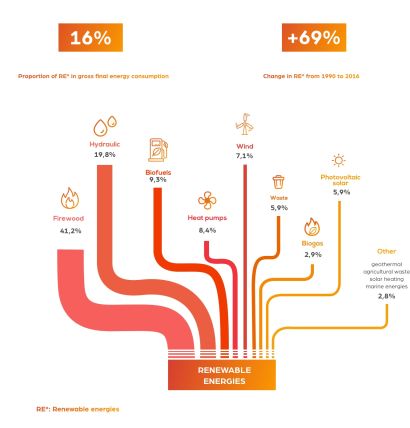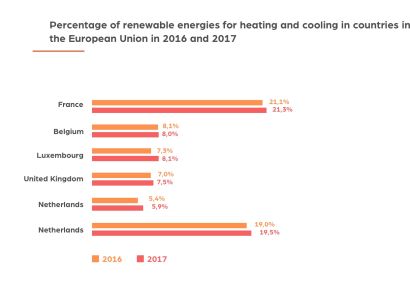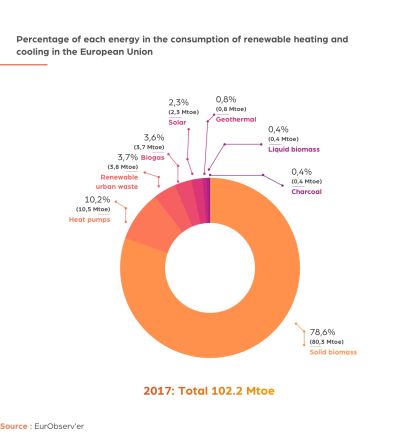
Energy savings, respect for the environment, sustainable resource management, not forgetting out wellbeing. These can all be ensured by biomass, and firewood in particular. A quick overview of the energy for our immediate future.
We talk about it every day. In the media, with colleagues or our family. Our energy consumption model is leading us towards an impasse. Overconsumption of fossil fuels, gas, oil and coal is causing significant climate and environmental changes, and the consequences are all too real. It is high time that we speed up the switch to renewable energy resources, in order to ensure nothing more nor less than our survival.
In 2016, 17% of the energy consumed in Europe came from renewable sources. Europe has set itself the target of increasing this to 32% by 2030.
And biomass represents a major asset when it comes to achieving this target: 41.2%* of the renewable energy that is currently consumed comes from wood!
* France, 2016
Biomass is quite simply all the plant- or animal-based materials present on our planet, including organic waste and plant residues.
Biomass can be grouped into 2 main categories: wet (organic waste, plant residues etc.) and dry (logs and wood pellets in particular). Biomass is the oldest energy used by humans: when we discovered fire, we used biomass for the first time to provide light and heat.
In particular, biomass allows us to produce warmth and electricity.
As for wet biomass, it is put into a digester (a large enclosed container) to produce biogas, a gas that produces a lot of heat, via a biomethanisation process (anaerobic digestion). These industrial facilities supply the grid with electricity and in some cases heat, which is distributed locally via underground heating networks.
Dry biomass is usually simply burned, so we are mainly talking about firewood, usually in the form of logs or compacted sawmill waste (pellets).
Firewood is a renewable source of energy, as long as forests are managed sustainably. By compensating for cutting down trees by planting new ones, forests can replenish themselves faster than they are used up. This is the case in Europe: wooded areas are permanently growing!
Producing heat from wood using a modern device rather than non-renewable energy sources helps reduce our ecological impact. Indeed, the CO2 released during combustion corresponds to the quantities absorbed when the tree is growing. These emissions are more than offset by the CO2 absorbed by newly planted trees and growing forests. In European forestry businesses, if they are managed sustainably, the carbon footprint for heating with wood is therefore neutral. Heating with wood produced by local companies is an integral part of a “natural cycle”. Using locally produced wood helps significantly reduce our impact on climate change. Whilst also protecting European forests, which are “carbon sinks”, absorbing 10% of the CO² emitted every year (all sources combined).
In 2016, in France 16%** of the energy consumed came from renewable sources. This renewable energy can be broken down as follows:

We can see that firewood covers 41.2% of renewable energy inputs, far ahead of hydraulic, wind and solar power!
If we focus on heat production, in France, 21.3% of energy comes from renewable sources. Biomass represents 78.6% of this renewable energy. (source: The State of Renewable Energies 2017, 2018 EurObserv’ER report).
Indeed, combining the individual wood heating devices used by 50% of households in France puts firewood far ahead of heat pumps (10.2%) and solar heating (2.3%) when it comes to producing heat from renewable energy sources.


And the contribution of firewood to renewable energy figures is only going to increase in the future.
Indeed, our nations need to respect the targets for energy produced from renewable sources in final energy consumption (heating + electricity + transport).
In 2016, this percentage was 16% for France (with a 2020 target of 23%), and 8.7% for Belgium (2020 target of 13%).
Europe has set itself the goal of producing 32% of energy consumed from renewable energy sources by 2030. And biomass is doing well in Europe when it comes to reaching this target.
Firewood boasts lots of advantages, both economical and ecological, making it an ideal source of energy.
Economic advantages:
- Biomass is readily available in Europe: forests, grasslands and cultivated land is plentiful here. Sustainable management is obligatory, and demonstrates that replacement exceeds felling.
- Biomass represents an opportunity for European businesses to lead the way when it comes to technological innovation, in order to set ourselves free from reliance on fossil fuels.
- Local use of biomass supports a local economy with a short supply chain, and creates sustainable local jobs that cannot be relocated.
- firewood is a local energy source; far less energy is needed to extract, process and transport it than fossil or nuclear fuels. Local biomass requires much less grey energy than fossil fuels, which need to be extracted from sources further and further away, at greater and greater depths. And that has an economic impact as well: between 1998 and 2013, the cost of oil extraction tripled!
- For private individuals, energy bills are reduced. Heating with wood, as well as being pleasurable, is more economical than heating with oil or gas. The price remains stable and is not subject to speculation.
As well as that, this source of renewable energy is easy to store.
Environmental advantages:
- Carbon neutral: planting new trees and growing forests offsets the CO2 released into the atmosphere by burning wood. Carbon is once again absorbed when trees or plants grow. This makes wood carbon neutral.
Heating using wood is therefore an integral part of a “natural cycle”, significantly reducing our ecological footprint and our impact on climate change.
In the south of Belgium, land covered by forest has increased by 25% over the last 100 years, and now occupies 30% of the country’s surface area. The permanent growth of woodland proves that the wood cut down on European land is replanted, and that wood as a resource, like all biomass, is constantly being renewed.
- At the moment, 25% of Walloon homes and 1 in 2 French homes have woodburning heating devices. But if all heating devices fuelled by fossil fuels were replaced with modern ones fuelled by wood, the impact of total CO2 emissions will be significantly reduced.
We are lucky in Europe. Our continent is full of biomass resources.
That is why we have the opportunity to tackle climate challenges with new ways of producing energy, which are far more in tune with the environment, like firewood. Modern Stûv fires, inserts or stoves, fuelled by logs or pellets, perform impressively, with somewhere in the region of more than 80% efficiency, a long way away from open fires from times gone by. So we can enjoy the benefits of biomass in our own homes, via our very own “firewood” power station, with added enjoyment.
To conclude, we should point out that in France and in other countries, there are public subsidies (CITE, éco-PTZ, éco-subvention Anah, etc.) to encourage the installation of wood-heating devices by qualified professionals. Always good to know when you want to combine savings, comfort and respect for the environment.